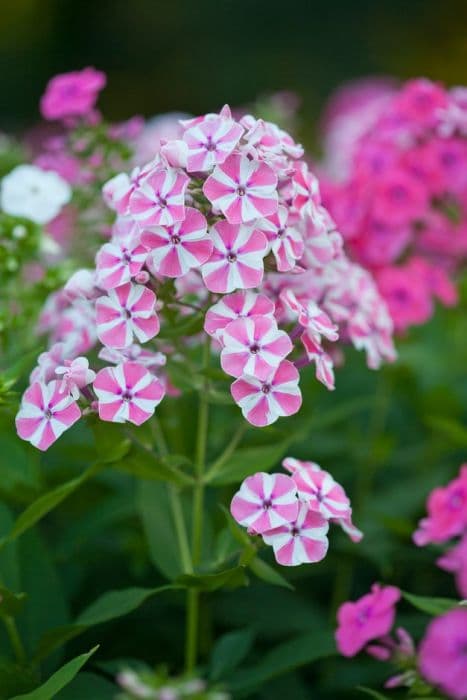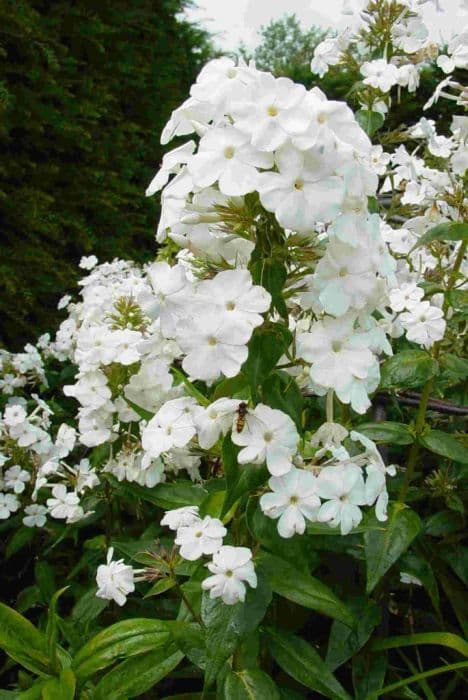Garden Phlox Phlox paniculata 'Peppermint Twist'

ABOUT
Peppermint Twist is a distinctive variety of the summer phlox known for its unique flowers. The blossoms are striking, showcasing a pattern of pink and white stripes that give the plant its candy-themed name. Each petal is a combination of bright pink with a swirling ribbon of white, reminiscent of the spirals on a peppermint candy. These flowers are usually arranged in large, showy clusters that can contribute a vibrant pop of color to any garden space. The leaves of Peppermint Twist are deep green, providing a lush backdrop that further accentuates the vivid hues of the blossoms. Its foliage is typically oblong with a smooth, sometimes slightly glossy appearance. The overall structure of the plant is upright, with strong stems that hold the flower clusters. As a summer-blooming perennial, Peppermint Twist also has the ability to attract pollinators such as butterflies, adding not just visual beauty but also ecological value to its surroundings.
About this plant
 Names
NamesFamily
Polemoniaceae
Synonyms
Summer Phlox, Garden Phlox, Perennial Phlox, Tall Phlox
Common names
Phlox paniculata 'Peppermint Twist'
 Toxicity
ToxicityTo humans
Garden Phlox is not known to be toxic to humans. It is generally considered safe and does not typically cause adverse reactions when handled or accidentally ingested in small quantities. However, as with any plant, individual allergies can occur, so it's always wise to exercise caution and avoid consuming any plant material unless you are certain of its safety. If someone has a specific sensitivity or allergy to Garden Phlox, they could experience symptoms such as skin irritation or gastrointestinal discomfort.
To pets
Garden Phlox is not known to be toxic to pets. It is generally considered safe and is not listed among the commonly known poisonous plants for pets such as dogs and cats. However, consuming any plant material can potentially lead to gastrointestinal upset in pets such as vomiting or diarrhea, particularly if ingested in large quantities. If a pet shows any unusual symptoms after consuming any part of the Garden Phlox, it is advisable to consult a veterinarian.
 Characteristics
CharacteristicsLife cycle
Perennials
Foliage type
Deciduous
Color of leaves
Green
Flower color
Pink
Height
2-3 feet (0.6-0.9 meters)
Spread
2 feet (0.6 meters)
Plant type
Herb
Hardiness zones
4
Native area
North America
Benefits
 General Benefits
General Benefits- Attracts Pollinators: The Phlox paniculata 'Peppermint Twist', commonly known as Garden Phlox, is known for attracting bees, butterflies, and other beneficial insects to the garden, aiding in pollination.
- Colorful Blooms: This variety offers distinctive pink and white striped flowers that add a splash of vibrant color to the garden landscape.
- Fragrance: Garden Phlox emits a sweet fragrance that can be enjoyed when planted near walkways or sitting areas.
- Long Blooming Period: It typically has a lengthy flowering season from mid to late summer, providing long-lasting garden interest.
- Hardiness: Garden Phlox is known for being a hardy perennial that can withstand various climate conditions once established.
- Height and Structure: It grows to provide vertical interest in borders or beds, with a height that can add structure to the design of a garden.
- Easy to Grow: Phlox paniculata 'Peppermint Twist' is considered easy to cultivate and does not require expert gardening skills to maintain.
- Cut Flower: Its blooms make excellent cut flowers for indoor arrangements.
- Resistant to Deer: Garden Phlox is generally resistant to deer, making it an excellent choice for gardens in areas with high deer populations.
 Medical Properties
Medical PropertiesThis plant is not used for medical purposes.
 Air-purifying Qualities
Air-purifying QualitiesThis plant is not specifically known for air purifying qualities.
 Other Uses
Other Uses- Crafting homemade dyes: Phlox's flowers can be used to create natural dyes for fabric, offering hues ranging from pink to light purple depending on the mordant used.
- Photography backdrop: Garden Phlox, with its vivid flowers, can serve as an attractive backdrop for photographers, especially for portraits or macro photography.
- Culinary decoration: The edible flowers of Garden Phlox can add a colorful garnish to salads, desserts, and drinks.
- Butterfly gardens: Phlox paniculata 'Peppermint Twist' is a great addition to butterfly gardens as it attracts various species with its nectar-rich flowers.
- Floral art: The distinctive striped petals of this cultivar can be used in pressed flower projects or other floral art designs.
- Teaching tool: Educators can use the plant to teach students about pollination, as it is a favored plant for pollinators like bees and butterflies.
- Themed gardens: This plant can be included in a "candy-themed" garden due to its peppermint twist appearance, offering a whimsical touch.
- Essence making: While not medicinal, the flowers can be used to create floral essences for perfumes or scented waters.
- Eco-friendly confetti: Dried petals of Garden Phlox can serve as biodegradable confetti for events and celebrations.
- Seed saving for educational projects: Harvesting seeds from Phlox paniculata 'Peppermint Twist' can be used as a hands-on educational activity to teach about plant life cycles and propagation.
Interesting Facts
 Feng Shui
Feng ShuiGarden Phlox is not used in Feng Shui practice.
 Zodiac Sign Compitability
Zodiac Sign CompitabilityGarden Phlox is not used in astrology practice.
 Plant Symbolism
Plant Symbolism- Harmony and Unity: Phlox, in general, symbolizes harmony and the matching of personalities, much like its own clustered flowers that form a cohesive whole.
- Proposal and Agreement: Giving phlox flowers is sometimes associated with proposing a union, be it in love or business, as it signifies agreement and mutual understanding.
- Sweet Dreams: Phlox is also known to represent sweet dreams and wishes, often given with the hope that the recipient will have peaceful and pleasant thoughts.
- Partnership: With 'Peppermint Twist's' distinctive stripes, it may suggest the importance of partnership and blending of differences to make a beautiful whole.
 Water
WaterGarden Phlox requires regular watering, especially during dry spells. It is ideal to water deeply once a week, providing about one inch of water each time. You can measure this by placing a container near the plant and ensuring it fills up to the one-inch mark after you water. Avoid overhead watering to reduce the risk of fungal diseases. Instead, water at the base of the plant early in the day, allowing the foliage to dry before evening. During hot or especially dry periods, you may need to increase the frequency to twice a week.
 Light
LightGarden Phlox thrives in full sunlight but can tolerate partial shade. The best location is where it can receive at least six hours of direct sunlight daily. They perform well when planted in a spot that gets morning sun and afternoon shade, especially in hotter climates to prevent the midday sun from scorching the foliage.
 Temperature
TemperatureGarden Phlox is hardy and can tolerate a wide range of temperatures. It typically can survive minimum temperatures down to -20°F to -30°F and maximum temperatures as high as 90°F to 100°F. However, the ideal temperature range for growing Garden Phlox is between 60°F and 70°F. Providing mulch can help maintain a more consistent root temperature.
 Pruning
PruningPruning Garden Phlox is important for maintaining its health and encouraging lush, full growth. Deadhead spent blooms regularly throughout the blooming season to encourage more flowers. Cut back the foliage to within a couple of inches of the ground in late fall or early spring, as new growth begins to emerge. This will help prevent disease and promote vigorous new growth.
 Cleaning
CleaningAs needed
 Soil
SoilGarden Phlox, specifically the 'Peppermint Twist', thrives best in a soil mix that is rich in organic matter with good drainage. A blend of garden soil, compost, and peat or a high-quality potting mix with a touch of perlite or coarse sand ensures optimal health. The ideal pH for this phlox should be mildly acidic to neutral, ranging from 6.0 to 7.0.
 Repotting
RepottingGarden Phlox like 'Peppermint Twist' doesn't need frequent repotting as it is typically grown as a perennial in the garden. In containers, repotting can be done every 2-3 years in spring to renew the soil and accommodate root growth. It's less about repotting and more about dividing clumps in the garden every 3-4 years to maintain vigor.
 Humidity & Misting
Humidity & MistingGarden Phlox prefers outdoor conditions where humidity is naturally regulated. 'Peppermint Twist' does well in average humidity levels and doesn't require specific humidity adjustments. It's resilient but ensure it's planted in a location with good air circulation to prevent mildew, which can be a concern at high humidity levels.
 Suitable locations
Suitable locationsIndoor
Use bright light, well-draining soil, and ample space.
Outdoor
Plant in sun to part shade, rich, moist soil, mulch well.
Hardiness zone
4-8 USDA
 Life cycle
Life cycleThe life of Phlox paniculata 'Peppermint Twist', commonly known as Garden Phlox, begins with seed germination, where environmental conditions such as light exposure and moisture prompt seeds to sprout. Following germination, it enters the vegetative stage, developing roots, stems, and leaves as it establishes itself, growing rapidly during spring and early summer. The plant reaches maturity in the flowering stage, typically in midsummer, when it produces clusters of pink and white striped flowers that attract pollinators. After pollination, seeds form within the flowers and eventually disperse, completing the reproductive stage. The plant then goes into a stage of senescence in late autumn, where above-ground parts die back with the onset of colder temperatures. Throughout winter, the plant lies dormant, with root systems remaining alive under the soil, ready to rejuvenate in the next growing season.
 Propogation
PropogationPropogation time
Early Spring
The most popular method of propagation for Garden Phlox, specifically the 'Peppermint Twist' variety, is through root cuttings. This process is generally done in the early spring when plants are coming out of dormancy or in the late fall once the plants have died back. To propagate through root cuttings, one would dig around the base of a healthy parent plant, being careful not to damage the main root system, and then select a section of root that is about 1/4 inch (approximately 6 millimeters) in thickness. This section is then cut into pieces about 2 inches (roughly 5 centimeters) long. These cuttings should be planted horizontally, approximately 1 inch (2.5 centimeters) deep, in a moist, well-draining propagation medium. Over the following weeks, kept under the appropriate conditions of warmth and humidity, these cuttings will usually sprout new shoots, and eventually new plants can be transplanted into the garden.









